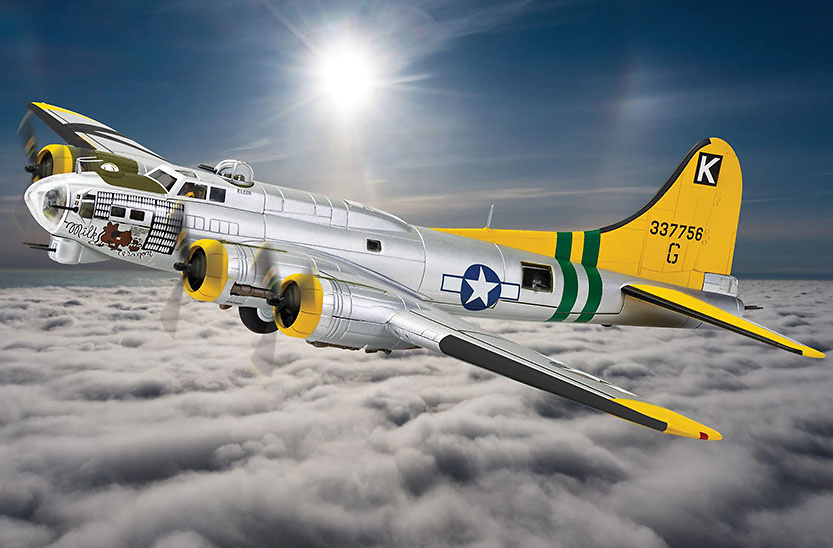During the tumultuous years of World War II, one aircraft emerged as a symbol of American airpower and resilience: the Boeing B-17G Flying Fortress. Known for its rugged durability, long-range capabilities, and formidable defensive armament, the B-17G became a legend in the skies over Europe and the Pacific. This iconic bomber not only played a pivotal role in the Allied victory but also redefined the very nature of aerial warfare.
The Birth of a Legend
The Boeing B-17 was initially conceived in the 1930s as a strategic bomber capable of long-range missions. However, it was the B-17G variant, introduced in 1943, that truly cemented the aircraft’s place in history. The B-17G was an evolution of earlier models, featuring significant enhancements that made it the most capable and feared version of the Flying Fortress.
One of the most notable upgrades in the B-17G was the addition of a chin turret, which housed two .50-caliber machine guns. This new turret, along with the aircraft’s other defensive positions—tail, waist, dorsal, and ball turrets—gave the B-17G unparalleled firepower. The aircraft could unleash a barrage of bullets from its 13 machine guns, effectively fending off enemy fighters from all directions. This formidable armament earned the B-17G its “Flying Fortress” nickname, as it was essentially a heavily armed fortress in the sky.

Missions of Daring and Destruction
The B-17G Flying Fortress was designed for strategic bombing missions deep into enemy territory. It excelled in this role, carrying up to 4,800 pounds of bombs over vast distances. With a range of over 2,000 miles and a cruising speed of 182 mph, the B-17G could reach and destroy key industrial and military targets in Nazi-occupied Europe.
Perhaps the most famous missions involving the B-17G were the daylight bombing raids over Germany. These missions were incredibly dangerous, as the bombers faced fierce resistance from both enemy fighters and anti-aircraft artillery. However, the B-17G’s rugged construction and self-sealing fuel tanks allowed many of these aircraft to return home despite sustaining heavy damage. Stories of B-17Gs limping back to base with massive holes in their wings or entire sections of their fuselage missing became legendary, furthering the aircraft’s reputation as an indestructible warbird.
The Human Element: Crews of Courage
While the B-17G Flying Fortress was an engineering marvel, it was the courage and skill of its crews that truly brought the aircraft to life. Each B-17G was manned by a ten-man crew, including a pilot, co-pilot, bombardier, navigator, and various gunners. These airmen were tasked with navigating treacherous skies filled with enemy fighters and flak, all while maintaining the precision needed to hit their targets.
Life aboard a B-17G was far from glamorous. The aircraft’s unpressurized cabin meant that crews had to endure freezing temperatures at high altitudes, often flying at 25,000 feet or higher. The noise from the engines and the constant threat of enemy attack added to the stress. Despite these hardships, the crews of the B-17G displayed unwavering bravery, completing countless missions that were crucial to the Allied war effort.

Legacy of the B-17G
The Boeing B-17G Flying Fortress played a key role in the Allied victory in World War II, particularly in the strategic bombing campaign that crippled Nazi Germany’s war production. By the end of the war, B-17s had dropped more than 640,000 tons of bombs, more than any other American aircraft. The B-17G’s contribution to the war effort was undeniable, and its legacy endures to this day.
Beyond its military achievements, the B-17G has become a cultural icon. The aircraft has been featured in numerous films, documentaries, and books, helping to keep the memory of its wartime service alive. Today, a few B-17Gs remain in flying condition, serving as a powerful reminder of the sacrifices made by the Greatest Generation. These surviving aircraft are treasured by aviation enthusiasts and historians alike, who continue to honor the men who flew and maintained them.

Conclusion
The Boeing B-17G Flying Fortress is more than just a bomber; it is a symbol of determination, resilience, and courage. Its role in World War II was critical to the success of the Allied forces, and its legacy continues to inspire generations. As we look back on the B-17G’s storied history, we remember the incredible feats of the aircraft and the brave crews who flew it, ensuring that the legend of the Flying Fortress will never be forgotten.





